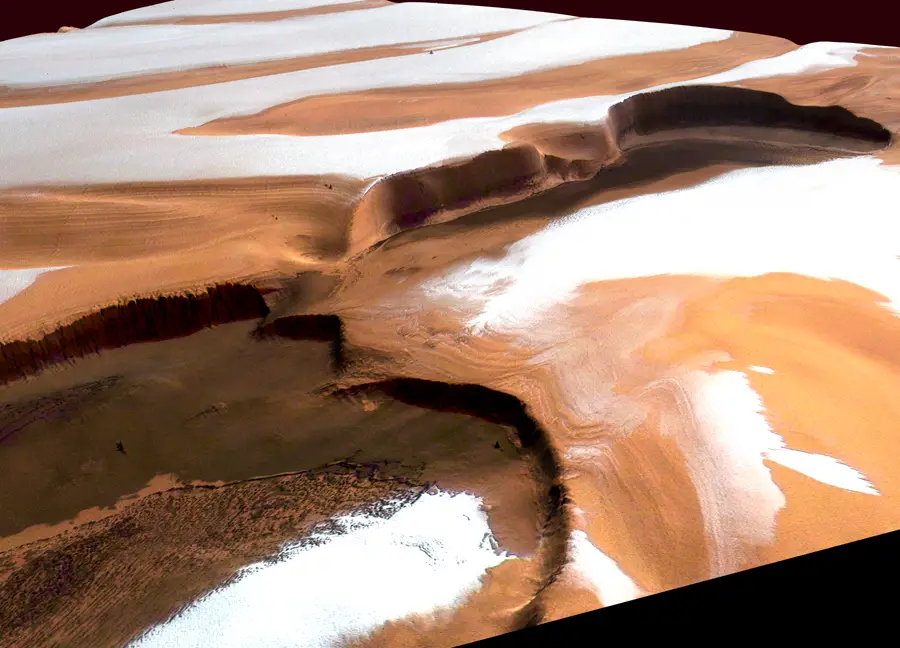Mars, also known as the “Red Planet,” has for a very long time piqued the interest of scientists and anyone who are enthusiastic about space travel. Mars, the planet that is immediately adjacent to Earth, has been the target of a great number of missions and explorations, and these endeavors have yielded a lot of information about the distinctive qualities that Mars possesses. One of the most fascinating aspects of Mars is that it has ice caps on both of its poles, which begs the question: does Mars have a North Pole?
It is necessary to investigate the topography and climate of Mars in order to comprehend the concept that the red planet possesses a North Pole. Mars, just like Earth, possesses polar ice caps that are situated close to its poles. The majority of these ice caps are made up of water ice and carbon dioxide ice, which is also referred to as dry ice. The polar ice caps of Mars have been the focus of intensive research, which has provided scientists with the opportunity to gain important new understandings on the temperature history of the planet and its capability of harboring life.
The polar regions of Mars are characterized by the presence of two separate ice caps, one of which may be found at the planet’s north pole and the other at its south pole. The northern ice cap, often known as the “North Polar Cap,” is the more compact of the two ice caps. Its diameter is somewhere in the neighborhood of 1,000 kilometers (620 miles), and the majority of its mass is made up of water ice. The southern ice cap, also known as the “South Polar Cap,” is considerably larger than its northern counterpart. It has a diameter of around 350 kilometers (217 miles) and is made up of a mixture of water ice and carbon dioxide ice.
Similar to the seasonal changes that occur in the polar regions of Earth, the ice caps at the poles of Mars also experience these shifts. As a result of the substantial drop in temperature that occurs during the Martian winter, a component of the atmosphere becomes condensed and deposits itself as frost on the polar caps. This mechanism causes the ice caps to expand, particularly the southern one because it is larger and contains a greater proportion of carbon dioxide ice. The growth of the ice caps is due to this process. The polar ice caps on Mars go through a process called sublimation when the Martian summer arrives. This is a process in which the ice directly converts into gas, which helps to replenish the Martian atmosphere.
The existence of these polar ice caps on Mars is evidence of the planet’s temperature history and the possibility that it formerly contained water, which is an essential component for the development of life on any planet. It is believed by scientists that Mars once had a thicker atmosphere and a gentler climate, both of which made it possible for liquid water to flow on its surface. This occurred billions of years ago. However, throughout the course of time, Mars lost a significant portion of its atmosphere and went through a drastic transformation, which resulted in the planet’s current chilly and dry characteristics.
The investigation of Mars has unearthed strong evidence that there is water ice hidden beneath the surface of the planet, notably in the polar regions. It has been discovered and confirmed by many spacecraft and rovers, such as NASA’s Phoenix Mars Lander and the Mars Reconnaissance Orbiter, that subsurface ice deposits are present on Mars. This finding lends credence to the theory that water may still be present on Mars in a frozen condition at the present time. As a result of these discoveries, there is a renewed sense of optimism regarding the viability of future human expeditions to Mars, which might also act as a stepping stone for the exploration of other parts of our solar system.
In conclusion, Mars does, in fact, possess a North Pole, much like Earth does, complete with a distinct polar ice cap. The North Polar Cap, which is primarily made up of water ice, is an important aspect to consider while trying to comprehend the climate and history of Mars. The existence of polar ice caps on Mars draws attention to the planet’s intriguing geology and the possibility of the presence of water on the surface of the planet, which is a necessary component for the emergence of life. We are inching closer to finding an answer to the profound question of whether or not there is life elsewhere in the universe as our knowledge of Mars continues to advance as a result of continuous missions and scientific discoveries. As these two factors work together, we are gradually gaining a better understanding of this mysterious planet.
![]()
